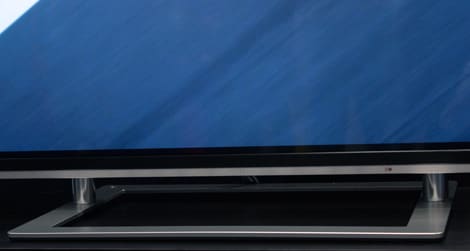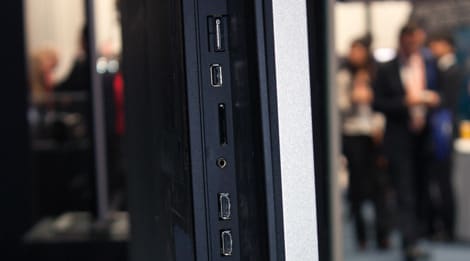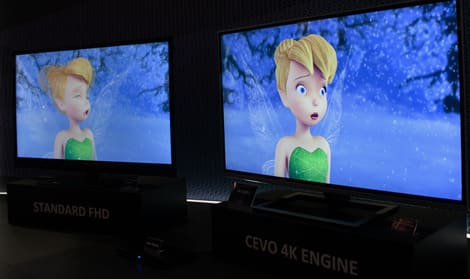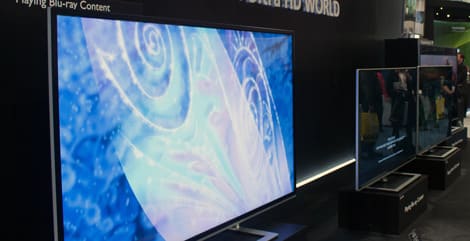Pros
Cons
Introduction
Toshiba's flagship TVs fall into the L9300 series this year, which comes in screen sizes of 58, 65, and 84 inches. While the reps we spoke to couldn't comment on pricing yet, they did confirm that the TVs would all be on the market by this summer. Like many other manufacturers, the L9300 series of smart TVs are of the 3D-ready, 240 Hz. LED variety.
Happily, though, Toshiba does more than to just slump along with the crowds. To this end, the company has what appears to be a ready answer for the glaring lack of native 4K content: a promising new "CEVO" (Cell Evolution) engine.
Design
{{section_header}}{{section.name}}{{/section_header}}
What's on the outside pales compared to what's on the inside.
The 58L9300U we saw on Toshiba's show floor was a finished version: the silver bezel, the square-branch platform stand, and the available ports and connectivity options were the same as what consumers will see when the series hits the market this summer.

As of right now, the L9300 series features a fairly standard array of connectivity options: 4 HDMI inputs, a LAN (ethernet) input, 2 USB ports, a high-resolution PC input, an IR blaster jack, and the usual component/composite inputs. This seemed like an odd port spread for a TV whose native resolution is something like sixteen times higher than the composite (standard definition) maximum—but then we noticed Toshiba's CEVO engine.

This CEVO (cell evolution) engine is a combination of two processors: one quad-core, one dual-core. The dedicated processors serve two different functions. The quad-core processor is committed wholly to upping and maintaining top-tier picture quality, and the dual-core processor is reserved primarily for upscaling non-4K content to "near 4K" standards. In short, this means that even standard definition content can be upscaled to grainy, but usable, quality. This capability sounds suspicious on paper, to say the least, but after seeing it in action, we can reasonably say that the feature is at least somewhat appreciable.

Where this feature really shines is in the upscaling of 1080p content to what I'd call "imitation" 4K. The picture above doesn't really do it justice—we saw clear improvements to contrast, color vivacity, and edge gradation (the latter of which makes ultra high definition special, in my opinion) over the regular 1080p movie. Both were sourced from a 1080p Blu-ray player, with the UHDTV apparently upscaling through a proprietary backlight, and effecting as many as 6 million pixels without artifacts or texture problems.
The CEVO engine is easily the most intriguing part of Toshiba's UHDTV line-up. The upscaled image wasn't of the same quality as native 4K, of course, but it's a clever answer to the no-content problem.
{{photo_gallery "FI Front Image", "FI Back Image", "FI Left Image", "FI Right Image", "FI Stand Mount Image", "FI Ports Image 1", "FI Ports Image 2", "FI Controls Image"}}
Smart TV Features
{{section_header}}{{section.name}}{{/section_header}}
The L9300U series will feature Toshiba's new platform: Cloud TV.
While we weren't able to see the Cloud TV platform on the show floor, we did get a glimpse of it during Toshiba's cocktail party on Sunday. Each of the L9300U UHDTVs will be Wi-Fi ready and LAN capable, and we imagine this slew of processing power could potentially contribute greatly to the speed and efficacy of Toshiba's smart platform.
For a more in-depth look at Cloud TV, click here.
{{photo_gallery "FI Menu Image 1", "FI Menu Image 2", "FI Menu Image 3", "FI Remote Image"}}
Conclusion
{{section_header}}{{section.name}}{{/section_header}}
Toshiba is making strides to stand out from... well, let's call it the "4Krowd"
At this point, we've seen all walks of UHDTVs from Samsung, LG, Sony, Panasonic, Sharp, and Toshiba. There are slight variations, but the common component is unfortunately the crippling asking price. And even if money is no object, early adopters must still swallow the hard-cheese of waiting for the media market to catch up with UHD resolution.
While Sony has promised a small handful of pre-packaged 4K content on its UHD TVs, nearly none have offered an encouraging answer to the bereft-of-content UHD market itself. Ultimately, it's even possible that ultra high definition monitors will sell better than UHDTVs right now.

The 58L9300U is not head and shoulders above the competition, but Toshiba's Cell Evolution 4K Engine looks very promising, based on what we've seen so far. Toshiba claims to have been testing the waters of 4K tech all last year while selling to Europe and Japan—that move may pay off. The CEVO engine is not a perfect response to the need for content, but we think it's a great start.
The L9300 series will be available this summer in 58, 65, and 84-inch sizes.
Specs
{{manufacturer_specs_table}}
Meet the tester
Lee was Reviewed's point person for most television and home theater products from 2012 until early 2022. Lee received Level II certification in TV calibration from the Imaging Science Foundation in 2013. As Editor of the Home Theater vertical, Lee oversaw reviews of TVs, monitors, soundbars, and Bluetooth speakers. He also reviewed headphones, and has a background in music performance.
Checking our work.
Our team is here to help you buy the best stuff and love what you own. Our writers, editors, and experts obsess over the products we cover to make sure you're confident and satisfied. Have a different opinion about something we recommend? Email us and we'll compare notes.
Shoot us an email

